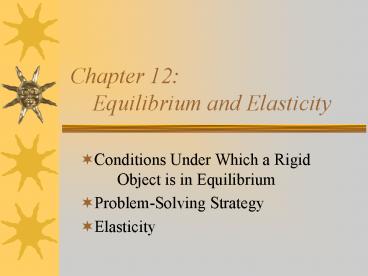Chapter 12: Equilibrium and Elasticity - PowerPoint PPT Presentation
1 / 19
Title:
Chapter 12: Equilibrium and Elasticity
Description:
Chapter 12: Equilibrium and Elasticity Conditions Under Which a Rigid Object is in Equilibrium Problem-Solving Strategy Elasticity Equilibrium: An object at ... – PowerPoint PPT presentation
Number of Views:106
Avg rating:3.0/5.0
Title: Chapter 12: Equilibrium and Elasticity
1
Chapter 12 Equilibrium and Elasticity
- Conditions Under Which a Rigid Object is in
Equilibrium - Problem-Solving Strategy
- Elasticity
2
Equilibrium
3
Conditions of Equilibrium
Net force Net
torque
Conditions of equilibrium
Another requirements for static equilibrium
4
The center or gravity
- The gravitational force on a body effectively
acts at a single point, called the center of
gravity (cog) of the body. - the center of mass of an object depends on its
shape and its density - the center of gravity of an object depends on its
shape, density, and the external gravitational
field. - Does the center of gravity of the body always
coincide with the center of mass (com)?
Yes, if the body is in a uniform gravitational
field.
5
How is the center of gravity of an object
determined?
The center of gravity (cog) of a regularly shaped
body of uniform composition lies at its geometric
center. The (cog) of the body can be located by
suspending it from several different points. The
cog is always on the line-of-action of the force
supporting the object.
cog
6
Problem-Solving Strategy
- Define the system to be analyzed
- Identify the forces acting on the system
- Draw a free-body diagram of the system and show
all the forces acting on the system, labeling
them and making sure that their points of
application and lines of action are correctly
shown. - Write down two equilibrium requirements in
components and solve these for the unknowns
7
Sample Problem 12-1
- Define the system to be analyzed beam block
- Identify the forces acting on the system
- the gravitational forces mg Mg,
- the forces from the left and the right scales Fl
Fr - Draw a force diagram
- Write down the equilibrium requirements in
components and solve these for the unknowns
8
Elasticity
- Some concepts
- Rigid Body
- Deformable Body
- elastic body rubber, steel, rock
- plastic body lead, moist clay, putty
- Stress Deforming force per unit area (N/m2)
- Strain unit deformation
9
Youngs Modulus Elasticity in Length
The Youngs modulus, E, can be calculated by
dividing the stress by the strain, i.e.
where (in SI units) E is measured in newtons
per square metre (N/m²). F is the force,
measured in newtons (N) A is the cross-sectional
area through which the force is applied, measured
in square metres (m2) ?L is the extension,
measured in metres (m) L is the natural length,
measured in metres (m)
10
Table 12-1 Some elastic properties of selected
material of engineering interest
Material Density ? (kg/m3) Youngs Modulus E (109N/m2) Ultimate Strength Su (106N/m2) Yield Strength Sy (106N/m2)
Steel 7860 200 400 250
Aluminum 2710 70 110 90
Glass 2190 65 50 ?
Concrete 2320 30 40 ?
Wood 525 13 50 ?
Bone 1900 9 170 ?
Polystyrene 1050 3 48 ?
11
Shear Modulus Elasticity in Shape
The shear modulus, G, can be calculated by
dividing the shear stress by the strain, i.e.
where (in SI units) G is measured in
newtons per square metre (N/m²) F is the force,
measured in newtons (N) A is the cross-sectional
area through which the force is applied, measured
in square metres (m2) ?x is the horizontal
distance the sheared face moves, measured in
metres (m) L is the height of the object,
measured in metres (m)
12
Bulk Modulus Elasticity in Volume
The bulk modulus, B, can be calculated by
dividing the hydraulic stress by the strain,
i.e. where (in SI units) B is measured
in newtons per square metre (N/m²) P is measured
in in newtons per square metre (N/m²) ?V is the
change in volume, measured in metres (m3) V is
the original volume, measured in metres (m3)
13
Youngs modulus Shear modulus Bulk modulus
Under tension and compression Under shearing Under hydraulic stress
Strain is Strain is Strain is
14
Summary
- Requirements for Equilibrium
- The cog of an object coincides with the com if
the object is in a uniform gravitational field. - Solutions of Problems
- Elastic Moduli
- tension and compression
- shearing
- hydraulic stress
- Define the system to be analyzed
- Identify the forces acting on the system
- Draw a force diagram
- Write down the equilibrium requirements in
components and solve these for the unknowns
15
Sample Problem 12-2
- Define the object to be analyzed firefighter
ladder
- Identify the forces acting on the system
- the gravitational forces mg Mg,
- the force from the wall Fw
- the force from the pavement Fpx Fpy
- Draw a force diagram
- Write down the equilibrium requirements in
components and solve these for the unknowns
16
Sample Problem 12-3
17
- Write down the equilibrium requirements in
components and solve these for the unknowns
Balance of torques
Balance of forces
18
Sample Problem 12-6
- Define the system to be analyzed table plus
steel cylinder.
- Identify the forces acting on the object
- the gravitational force (Mg),
- the forces on legs from the floor (F1 F2 F3 and
F4).
19
- Write down the equilibrium requirements in
components and solve these for the unknowns
Balance of forces
If table remains level































